Paul McCartney died in 1966 and was replaced by a look-alike imposter. He never played the half-time show at the Super Bowl. He was never knighted by Queen Elizabeth. And, he never married or fathered his four children. Actually, the remaining Beatles members covered up his death to keep their band together and on the rise, or so crazed conspiracy theorists believe. These theorists point out that the remaining Beatles started hiding hints in their music that the real Paul was dead. They believe every song on the Sgt. Pepper’s Lonely Hearts Club Band album is full of clues suggesting Paul’s death. In this album, The Beatles had assembled a new band with an imaginary member named Billy Shears. Believers of the conspiracy think that this fictional member was named for Paul’s 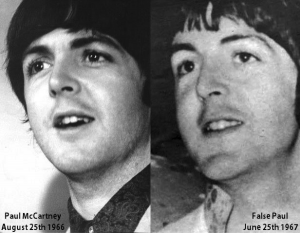 replacement. In the song “A Day in the Life,” the lyrics say: “he blew his mind out in a car.” When you play the song “I’m So Tired” backwards, you hear the lines “Paul is dead, miss him, miss him.” At the end of “Strawberry Fields Forever,” John Lennon sings, “I buried Paul,” though he later claims to have said “cranberry sauce” and “I’m very bored.” Believers in the Paul-is-dead conspiracy also find their proof in the backwards loops of songs and on album covers, which show things like raw meat and doll limbs (1966’s Yesterday and Today). Finally, on the cover of the Sgt. Pepper’s Lonely Hearts Club Band, there is a yellow wreath of flowers in the shape of a bass guitar, which believers think stands for a memorial to the real Paul McCartney.
replacement. In the song “A Day in the Life,” the lyrics say: “he blew his mind out in a car.” When you play the song “I’m So Tired” backwards, you hear the lines “Paul is dead, miss him, miss him.” At the end of “Strawberry Fields Forever,” John Lennon sings, “I buried Paul,” though he later claims to have said “cranberry sauce” and “I’m very bored.” Believers in the Paul-is-dead conspiracy also find their proof in the backwards loops of songs and on album covers, which show things like raw meat and doll limbs (1966’s Yesterday and Today). Finally, on the cover of the Sgt. Pepper’s Lonely Hearts Club Band, there is a yellow wreath of flowers in the shape of a bass guitar, which believers think stands for a memorial to the real Paul McCartney.
This famous conspiracy was developed in the 1960s but resurfaced after several websites claimed that Ringo Starr admitted to hiding Paul’s death in a recent, secret interview, according to United Kingdom’s The Mirror. Other prestigious publications, Time magazine being one of them, have published articles on this famed conspiracy. When I hear about things like this, I wonder how people find time to comb over everything Beatles in search for proof that today’s Paul McCartney is actually one lucky phony named Billy Shears. Apparently, because the Paul McCartney on the cover of the Beatles’ album Abbey Road is barefoot, means that he had died three years earlier.
Think these Paul-is-dead believers are off their rockers? Beatlemania sparked some even crazier conspiracy theories over the years: All of the Beatles died and were secretly replaced—except for Paul McCartney, several different imposters have acted as the real Beatles over the years, and my personal favorite, the illuminati formed the band in attempt to hypnotize youth listeners with subliminal messages advocating drug use which would alter their personalities. Others believe that the band members murdered their original drummer, Pete Best, and that the band has several songs that they’ve kept hidden in the event that they ever need more money,
Reading up on the madness that surrounds Beatle conspiracy theories, I began to wonder, are there any equally wild conspiracy theories about what we consider “classic” literature? So naturally I typed “literary conspiracy theories” into a Google search and not shockingly came across about 683 thousand results about classic literary characters, plotlines, settings, authors, and just about anything else you could think of.
 According to Norwegian filmmaker Nine Grunfeld, J.K. Rowling, author of the beloved Harry Potter series, does not exist. Grunfeld believes that no average working mom could become this idolized author, who published seven novels in ten years and sold over 250 million copies internationally. According to Grunfeld, there is no possible way that a nobody of an author could accomplish what “J. K. Rowling” has accomplished. Instead, the face we all know as the author of Harry Potter is just an actress who is the face for an entire team of writers.
According to Norwegian filmmaker Nine Grunfeld, J.K. Rowling, author of the beloved Harry Potter series, does not exist. Grunfeld believes that no average working mom could become this idolized author, who published seven novels in ten years and sold over 250 million copies internationally. According to Grunfeld, there is no possible way that a nobody of an author could accomplish what “J. K. Rowling” has accomplished. Instead, the face we all know as the author of Harry Potter is just an actress who is the face for an entire team of writers.
Some theorists believe that J.R.R. Tolkien and C.S. Lewis, two of the most famous fantasy authors of all time, were both members of the Occult and were using their fantasy novels to prepare the world for the New World that was coming. Tolkien’s Lord of the Rings series is claimed to have been an adapted version of a Wiccan text called The Book of Shadows. And Lewis, whose famous lion character Aslan is often called a Jesus-figure, is actually alluding to pagan deities. Theorists argue that in order to practice witchcraft, one must read all of C.S. Lewis’ works.
It’s only fitting that nobody knows how Edgar Allan Poe died. He arrived in Baltimore on October 3, 1849 wearing someone else’s clothes and acting delirious and strange. He mysteriously died four days later. One of the most widely-believed theories surrounding Poe’s death claims that Poe was kidnapped during election season. The kidnappers beat him and got him drunk, then took him to the polls and forced him to vote for their preferred candidate multiple times. The kidnappers then swapped around all of their hostages’ clothes so that none of them would be recognized and jailed for rigging the elections.
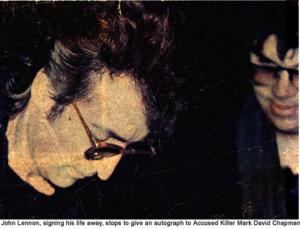 Finally, and most interestingly, some people actually believe that author Stephen King murdered John Lennon. In a book called Stephen King Shot John Lennon, author Steve Lightfoot argues that Richard Nixon and Ronald Reagan hired King as their henchman to kill John Lennon and end his peace protests once and for all. According to the conspiracy theorists, Mark David Chapman, the man who was blamed for killing John Lennon, was just an actor who was paid to take responsibility for the murder. There is a famous picture of John Lennon giving his alleged murderer, Chapman, his autograph mere hours prior to his murder, which is one of Lightfoot’s biggest supporting arguments. Lightfoot says that he has received multiple threatening letters from King to keep him from spreading information about the murder.
Finally, and most interestingly, some people actually believe that author Stephen King murdered John Lennon. In a book called Stephen King Shot John Lennon, author Steve Lightfoot argues that Richard Nixon and Ronald Reagan hired King as their henchman to kill John Lennon and end his peace protests once and for all. According to the conspiracy theorists, Mark David Chapman, the man who was blamed for killing John Lennon, was just an actor who was paid to take responsibility for the murder. There is a famous picture of John Lennon giving his alleged murderer, Chapman, his autograph mere hours prior to his murder, which is one of Lightfoot’s biggest supporting arguments. Lightfoot says that he has received multiple threatening letters from King to keep him from spreading information about the murder.
Conspiracy theories are mind-boggling and make me wonder how people come up with these crazy ideas. In the end, however, I guess you could ask the same question of fiction writers because, as I found in my research, reading about these conspiracies is like reading a flash-detective story, where all of the clues are laid out to justify the outcome of the mystery.
–Emily Flippo

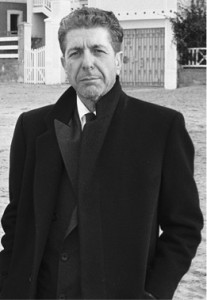
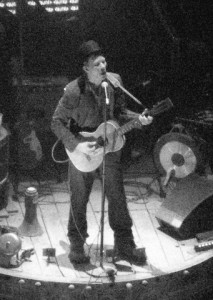
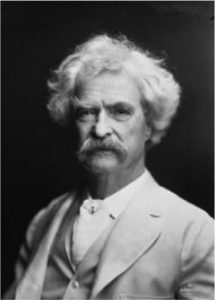
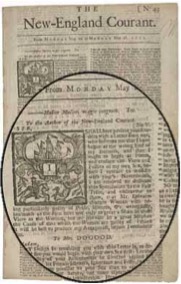

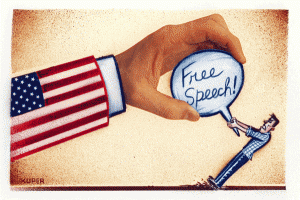 By the first line of a poem or a novel, I begin to dig deeper to try to understand its historical context, picturing the author as a historical actor or actress, inevitably influenced by his or her particular time and place. During my history seminar last semester, my extended research project focused on The New York Times v. Sullivan and the cases impact on the legal history of the Civil Rights Movement. Last week marked the 51st anniversary of the case and I have found myself, once again, combining my interests of literature and history, assessing how the case and its legacy of free speech relates to the publication of literature. While the majority of Americans view literature as a form of entertainment or art, literature has always been an effective and crucial actor in history. The New York Times v. Sullivan reveals the importance of the free press and journalism’s ability to bring about change, yet literature is just as much of a catalyst.
By the first line of a poem or a novel, I begin to dig deeper to try to understand its historical context, picturing the author as a historical actor or actress, inevitably influenced by his or her particular time and place. During my history seminar last semester, my extended research project focused on The New York Times v. Sullivan and the cases impact on the legal history of the Civil Rights Movement. Last week marked the 51st anniversary of the case and I have found myself, once again, combining my interests of literature and history, assessing how the case and its legacy of free speech relates to the publication of literature. While the majority of Americans view literature as a form of entertainment or art, literature has always been an effective and crucial actor in history. The New York Times v. Sullivan reveals the importance of the free press and journalism’s ability to bring about change, yet literature is just as much of a catalyst.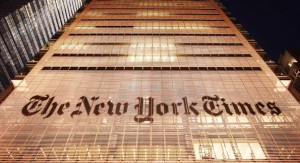 Fortunately, The New York Times appealed to the Supreme Court, which reversed the decision of the Alabama Court. The Court took the necessary measures to protect the rights of publications, understanding the importance of free speech in raising awareness and ensuring democracy, especially during at a time like the Civil Rights Movement.
Fortunately, The New York Times appealed to the Supreme Court, which reversed the decision of the Alabama Court. The Court took the necessary measures to protect the rights of publications, understanding the importance of free speech in raising awareness and ensuring democracy, especially during at a time like the Civil Rights Movement.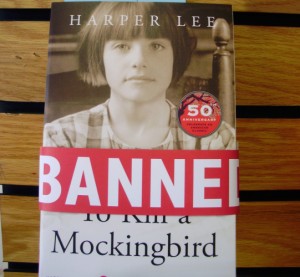 While we focus on the freedom of the press, freedom of all types of writing are critical to democracy. To Kill a Mockingbird, which is now a required read in most southern classrooms, was widely forbidden across the South. At the time, it was clear that the moving and authentic words of the story would inevitably cause even proponents of “separate but equal” to question their beliefs. After reading the novel, individuals across the nation altered their views, including James Carville who exclaimed, “It is because seeing things in writing brings change.” He continued that once he picked up the book, he immediately knew Harper Lee was right and he was wrong.
While we focus on the freedom of the press, freedom of all types of writing are critical to democracy. To Kill a Mockingbird, which is now a required read in most southern classrooms, was widely forbidden across the South. At the time, it was clear that the moving and authentic words of the story would inevitably cause even proponents of “separate but equal” to question their beliefs. After reading the novel, individuals across the nation altered their views, including James Carville who exclaimed, “It is because seeing things in writing brings change.” He continued that once he picked up the book, he immediately knew Harper Lee was right and he was wrong. resurgence in popularity of
resurgence in popularity of 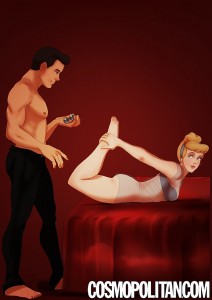
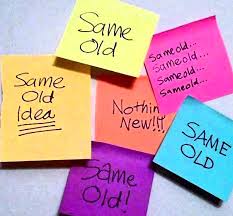
 very writer has his or her own routine. When I sit down to write anything, from a short reporting story to a 20-page research paper, I always sit in the same spot at the head of my dining room table with my pajamas and slippers on. I always have some sort of snack, usually something chocolatey. But, that’s not where my writing routine stops. I also can’t write without a jumbo glass of water with crushed ice. My dog is almost always at my side. So, in pursuit of an intriguing post, I asked myself, what do the most famous of authors do to prepare themselves to write?
very writer has his or her own routine. When I sit down to write anything, from a short reporting story to a 20-page research paper, I always sit in the same spot at the head of my dining room table with my pajamas and slippers on. I always have some sort of snack, usually something chocolatey. But, that’s not where my writing routine stops. I also can’t write without a jumbo glass of water with crushed ice. My dog is almost always at my side. So, in pursuit of an intriguing post, I asked myself, what do the most famous of authors do to prepare themselves to write?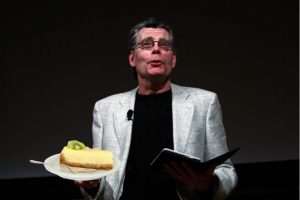 author, depends on cheesecake and beer to get his ideas flowing. King says that his sweet tooth has been passed down to his son, who eats crème brûlée for writing inspiration. King never goes to bars to drink because he says,“[bars are] full of assholes like me.” He drinks so much to write, that he claims to not remember writing his novel Cujo. One of King’s biggest fears is that sobriety will lead to the loss of his creativity.
author, depends on cheesecake and beer to get his ideas flowing. King says that his sweet tooth has been passed down to his son, who eats crème brûlée for writing inspiration. King never goes to bars to drink because he says,“[bars are] full of assholes like me.” He drinks so much to write, that he claims to not remember writing his novel Cujo. One of King’s biggest fears is that sobriety will lead to the loss of his creativity.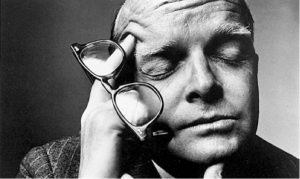
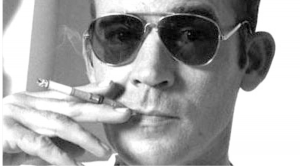
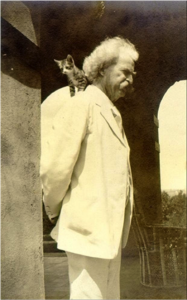 his chest; not easy to find in ordinary light.” The author of this advertisement? None other than Samuel Clemens, otherwise known as Mark Twain, himself. Though this specific ad was about his beloved cat Bambino, Twain collected a variety of other cats throughout the years as well. He loved cats so much that he once said, “I simply can’t resist a cat, particularly a purring one. They are the cleanest, cunningest, and most intelligent things I know, outside of the girl you love, of course.” Twain, however, is not the only writer who fancied feline friendship.
his chest; not easy to find in ordinary light.” The author of this advertisement? None other than Samuel Clemens, otherwise known as Mark Twain, himself. Though this specific ad was about his beloved cat Bambino, Twain collected a variety of other cats throughout the years as well. He loved cats so much that he once said, “I simply can’t resist a cat, particularly a purring one. They are the cleanest, cunningest, and most intelligent things I know, outside of the girl you love, of course.” Twain, however, is not the only writer who fancied feline friendship.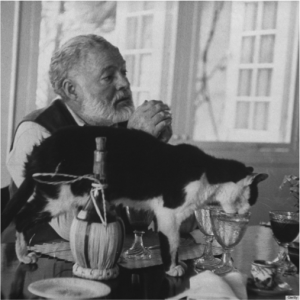 To this day, visitors can find more than 50 six-toed (polydactyl, to use the technical term) cats roaming around Hemingway’s home in Key West. It is said that they are the descendants of dear old Snowball.
To this day, visitors can find more than 50 six-toed (polydactyl, to use the technical term) cats roaming around Hemingway’s home in Key West. It is said that they are the descendants of dear old Snowball.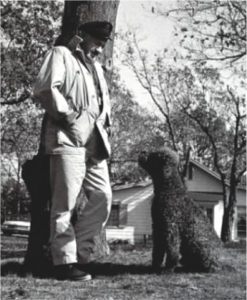
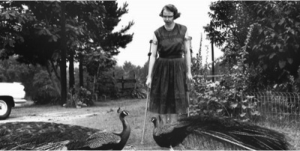 . And let us not forget about Flannery O’Connor and the famed peacocks that kept her company. She once wrote of them, “Visitors to our place, instead of being barked at by dogs rushing from under our porch, are squalled at by peacocks whose blue necks and crested heads pop up from behind tufts of grass, peer out of bushes, and crane downward from the roof of the house, where the bird has flown, perhaps for the view.”
. And let us not forget about Flannery O’Connor and the famed peacocks that kept her company. She once wrote of them, “Visitors to our place, instead of being barked at by dogs rushing from under our porch, are squalled at by peacocks whose blue necks and crested heads pop up from behind tufts of grass, peer out of bushes, and crane downward from the roof of the house, where the bird has flown, perhaps for the view.”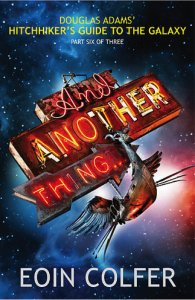
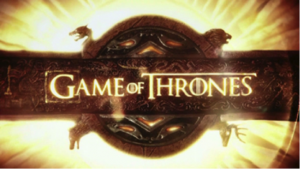
 deos of the passionate rhymes, personal stories, and well-placed f-bombs that general characterize a slam poem. Some nondescript night last year, I began a homework-avoiding binge of YouTube slams that led me to Dylan Garity’s “
deos of the passionate rhymes, personal stories, and well-placed f-bombs that general characterize a slam poem. Some nondescript night last year, I began a homework-avoiding binge of YouTube slams that led me to Dylan Garity’s “ I simply have such an appreciation for a medium that can so transform the way people see and become influenced by the arts, that I want to share it with others. I spend an immense amount of time finding videos and pictures and content on the Internet finding art. Sites like Pinterest, Stumble Upon, Tumblr, and yes, YouTube make arts more available, popular, and most importantly, experienced. I don’t have to visit a museum or gallery to appreciate a painting, because what’s most interesting to me is discovering a whole new art through the vessel of the web.
I simply have such an appreciation for a medium that can so transform the way people see and become influenced by the arts, that I want to share it with others. I spend an immense amount of time finding videos and pictures and content on the Internet finding art. Sites like Pinterest, Stumble Upon, Tumblr, and yes, YouTube make arts more available, popular, and most importantly, experienced. I don’t have to visit a museum or gallery to appreciate a painting, because what’s most interesting to me is discovering a whole new art through the vessel of the web.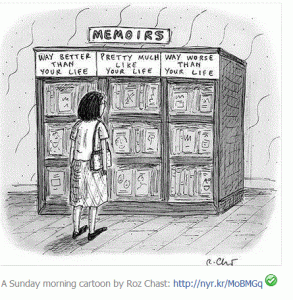 At one time memoir was considered a genre left for literary individuals or cultural figures who had lived life to the fullest or undergone some process of self-discovery that made their stories worthy of a public audience. But in recent years, this type of memoir has become overlooked and has been replaced, like a lot of great literature is, by works of nonfiction written by celebrities whose rise to stardom is deemed worthy of a book (i.e. whichever B-list celebrity publishers decide will make them the most money by writing about their drug problems, or embarrassing sexual endeavors) and memoirs that have on-screen potential.
At one time memoir was considered a genre left for literary individuals or cultural figures who had lived life to the fullest or undergone some process of self-discovery that made their stories worthy of a public audience. But in recent years, this type of memoir has become overlooked and has been replaced, like a lot of great literature is, by works of nonfiction written by celebrities whose rise to stardom is deemed worthy of a book (i.e. whichever B-list celebrity publishers decide will make them the most money by writing about their drug problems, or embarrassing sexual endeavors) and memoirs that have on-screen potential.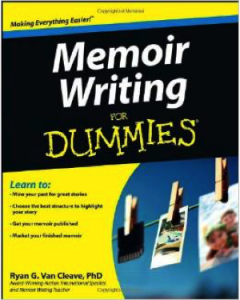 puter and the ability to form a sentence (although not always a grammatically correct one) thinks they can and should write a memoir; there is even a Memoir Writing for Dummies manual available for those just starting out. This both upsets me and excites me as a writer and reader of nonfiction. On the downside I see how this growing genre is becoming overly commercialized, but I also see how the influx of people writing memoir and creative nonfiction could potentially result in new icons of the genre.
puter and the ability to form a sentence (although not always a grammatically correct one) thinks they can and should write a memoir; there is even a Memoir Writing for Dummies manual available for those just starting out. This both upsets me and excites me as a writer and reader of nonfiction. On the downside I see how this growing genre is becoming overly commercialized, but I also see how the influx of people writing memoir and creative nonfiction could potentially result in new icons of the genre.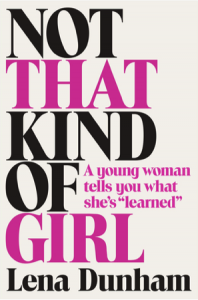 e for decades now, with nonfiction publishers clinging to the notion that the general public will want to know how stars and the elite made their fames and fortunes (or lost them both). In 2014 alone, Amy Poehler, Oprah Winfrey, Neil Patrick Harris, Lena Dunham, Alan Cumming, Rob Lowe, Danielle Fishel, Mario Lopez, and Joan Rivers all came out with memoirs. Other memoirs of the past decade include the highly successful Bossypants by Tina Fey and Mindy Kaling’s book, Is Everyone Hanging Out Without Me? (And Other Concerns). I have read many of these titles, and though I often found them comical and, occasionally, well written, they seem to blend into one indistinguishable memoir after time, with only a few strange or innovative pieces among them. Lena Dunham’s
e for decades now, with nonfiction publishers clinging to the notion that the general public will want to know how stars and the elite made their fames and fortunes (or lost them both). In 2014 alone, Amy Poehler, Oprah Winfrey, Neil Patrick Harris, Lena Dunham, Alan Cumming, Rob Lowe, Danielle Fishel, Mario Lopez, and Joan Rivers all came out with memoirs. Other memoirs of the past decade include the highly successful Bossypants by Tina Fey and Mindy Kaling’s book, Is Everyone Hanging Out Without Me? (And Other Concerns). I have read many of these titles, and though I often found them comical and, occasionally, well written, they seem to blend into one indistinguishable memoir after time, with only a few strange or innovative pieces among them. Lena Dunham’s 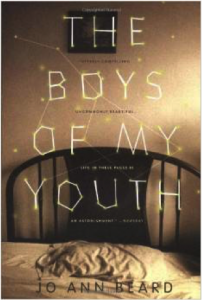 nd good for a thoughtless read on the beach, these types of memoirs do not give an accurate depiction of the genre as a whole. Memoirs like reality star Nicole “Snooki” Polizzi’s 2011 memoir Confessions of a Guidette is not a piece of literature that young nonfiction writers should aspire to emulate. Instead of emphasizing celebrities, drama, and historic figures, we need to consider emphasizing emerging memoirists who make the ordinary extraordinary or who are able to write with such candor and control that readers can tell they are reading the works of literary masters. I want to see memoirs like Mary Karr’s
nd good for a thoughtless read on the beach, these types of memoirs do not give an accurate depiction of the genre as a whole. Memoirs like reality star Nicole “Snooki” Polizzi’s 2011 memoir Confessions of a Guidette is not a piece of literature that young nonfiction writers should aspire to emulate. Instead of emphasizing celebrities, drama, and historic figures, we need to consider emphasizing emerging memoirists who make the ordinary extraordinary or who are able to write with such candor and control that readers can tell they are reading the works of literary masters. I want to see memoirs like Mary Karr’s